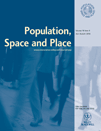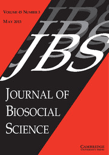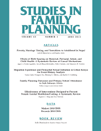
JOURNAL OF POPULATION RESEARCH
Scope & Guideline
Transforming data into impactful demographic knowledge.
Introduction
Aims and Scopes
- Demographic Dynamics and Changes:
Focuses on understanding trends in fertility, mortality, and migration across different regions and populations. This includes analyses of historical data and projections of future demographic shifts. - Socioeconomic Influences on Population:
Explores how economic conditions, education, and social structures impact population behaviors, such as fertility rates, marriage patterns, and health outcomes. - Public Health and Population Welfare:
Investigates the intersection of public health and demographic factors, emphasizing maternal and child health, reproductive health, and the impact of health policies on population outcomes. - Cultural and Ethnic Dimensions of Demography:
Examines how cultural beliefs, practices, and ethnic identities shape demographic behaviors, including family formation, fertility preferences, and health disparities. - Policy Analysis and Population Studies:
Analyzes the effects of various demographic and health policies on population trends and individual behaviors, providing insights for policymakers and stakeholders.
Trending and Emerging
- Impact of Global Crises on Population Dynamics:
Recent publications increasingly explore how global crises, such as the COVID-19 pandemic, impact fertility rates, mortality, and migration patterns, highlighting the need for adaptive policy responses. - Health Disparities and Indigenous Populations:
There is a notable rise in research focused on health disparities, particularly among indigenous populations, which emphasizes the importance of culturally sensitive approaches to health and demographic research. - Youth and Reproductive Transitions:
Emerging studies are focusing on youth demographics, particularly the timing and determinants of reproductive transitions among young adults, reflecting a shift towards understanding the unique challenges faced by this population. - Urbanization and Migration Patterns:
An increasing number of papers are analyzing the effects of urbanization on demographic behaviors, particularly regarding migration, housing, and family dynamics in urban settings. - Integration of Big Data and Demographic Research:
The use of big data analytics in demographic research is gaining traction, allowing for more nuanced insights into population trends and behaviors through innovative methodologies.
Declining or Waning
- Traditional Fertility Theories:
Research examining classic fertility theories and their applicability in contemporary settings has decreased, potentially due to shifting demographic patterns and the emergence of new factors influencing fertility. - Historical Demography Focus:
There appears to be a waning interest in strictly historical demographic studies, as the journal increasingly prioritizes current and future population dynamics over retrospective analyses. - Gender Roles and Fertility Studies:
While gender dynamics remain important, specific studies solely focused on traditional gender roles in fertility decisions are becoming less prominent, possibly overshadowed by broader socio-economic and health-related themes.
Similar Journals

Population Space and Place
Illuminating Spatial Dimensions of Demographic ChangePopulation Space and Place is an esteemed academic journal published by WILEY, dedicated to advancing the fields of demography and geography, planning, and development. With an impressive 2023 impact factor and categorized in the top quartile (Q1) for both demography and geography, this journal serves as a vital platform for researchers, professionals, and students seeking to explore the spatial dimensions of population dynamics. Founded in 2004 and running through 2024, it has established itself as a significant contributor to scholarly discussions, evidenced by its high Scopus rankings, including rank #18 out of 139 in demography and #165 out of 821 in geography and planning. While the journal currently does not offer open access, it remains a key resource for those involved in academic research and policy formulation. With its focus on the interplay between population trends and spatial analytics, Population Space and Place is essential for anyone aiming to understand the complexities of population geography in a rapidly changing world.

DEMOGRAPHY
Connecting research with real-world population challenges.DEMOGRAPHY is a prestigious, peer-reviewed journal published by DUKE UNIVERSITY PRESS, dedicated to advancing the field of demography through scholarly research and critical discourse. With an esteemed Q1 ranking in Social Sciences and an impressive Scopus rank of #10 out of 139 in the category, this journal holds a 93rd percentile status, reflecting its significant impact on the academic community. Covering a wide range of topics related to population studies, including fertility, mortality, migration, and demographic change, DEMOGRAPHY serves as a vital resource for researchers, professionals, and students alike. Since its inception in 1964, it has provided a platform for innovative studies and influential articles that address both theoretical frameworks and applied research. Although not an open-access journal, it ensures that its contributions reach a global audience while maintaining rigorous academic standards. Engage with DEMOGRAPHY to explore and contribute to the dynamic discussions shaping our understanding of human populations in a complex world.

Revista Latinoamericana de Poblacion
Unveiling the Complexities of Latin American DemographicsRevista Latinoamericana de Poblacion is a distinguished open-access journal dedicated to the field of population studies, published by the Asociación Latinoamericana de Población. Since its inception in 2007, the journal has aimed to foster scholarly dialogue and disseminate critical research on demographic dynamics across Latin America. With an emphasis on diverse methodologies and interdisciplinary approaches, the journal serves as a platform for researchers, professionals, and students to engage with pressing issues such as migration, fertility, aging, and socio-economic factors influencing population trends. As an invaluable resource for the academic community, this journal not only promotes accessibility to vital research through its open-access model but also plays a crucial role in enhancing the understanding of demographic changes and their implications in the region. By focusing on the unique context of Latin America, Revista Latinoamericana de Poblacion facilitates a deeper insight into population phenomena that resonate globally.

JOURNAL OF BIOSOCIAL SCIENCE
Investigating the Synergy of Social Structures and Biological FactorsJOURNAL OF BIOSOCIAL SCIENCE, published by Cambridge University Press, is a pivotal interdisciplinary journal dedicated to advancing our understanding of the complex interplay between biological and social factors in human health and society. With an ISSN of 0021-9320 and an E-ISSN of 1469-7599, this journal has been a cornerstone of scholarly communication since its inception in 1969, paving the way for innovative research until 2024 and beyond. The journal is ranked in the Q3 quartile in Public Health, Environmental and Occupational Health and Q2 in Social Sciences (miscellaneous), reflecting its significant impact in these fields. Its Scopus ranking further emphasizes its relevance, sitting at #79 out of 275 in General Social Sciences and #334 out of 665 in Public Health. Researchers, professionals, and students are encouraged to explore the journal's rich repository of articles that delve into critical biosocial issues, fostering a deeper understanding of how social structures influence health and well-being. Although not open access, the journal remains an essential resource for those committed to addressing contemporary health challenges through a biosocial lens.

POPULATION
Fostering Dialogue on Population Policy and TrendsPopulation, an esteemed journal published by the Institut National d'Études Démographiques (INED), serves as a critical platform for the dissemination of high-quality research in the field of demography. With the ISSN 0032-4663 (Print) and E-ISSN 1957-7966 (Online), this journal covers a wide spectrum of topics related to population studies, including migration, fertility, mortality, and population policy, offering a comprehensive lens on demographic trends that influence societies worldwide. Although it operates under a traditional subscription model, its rigorous peer-review process ensures that only the most impactful and relevant research findings are published. With its long-standing reputation among scholars and practitioners in the demographic domain, Population plays a vital role in shaping the academic discourse and guiding future research directions. Scholars, professionals, and students alike will find in its pages not only innovative perspectives but also critical insights that reflect the complexities of population dynamics in a rapidly changing world. For those dedicated to understanding the demographic challenges that societies face today, this journal remains an invaluable resource.

STUDIES IN FAMILY PLANNING
Innovating insights in reproductive health and social sciences.STUDIES IN FAMILY PLANNING, published by WILEY, is a renowned journal that serves as a critical resource in the fields of Demography and Social Sciences. With an impressive Q1 ranking in both categories, it is recognized for its high impact and influential contributions to the understanding of family planning dynamics, reproductive health, and population studies. The journal has published scholarly articles since 1970, reflecting its long-standing commitment to advancing knowledge and research in these important areas. Currently holding a rank of #27 out of 139 in Demography on Scopus, the journal's 2023 impact factor underscores its influential role in shaping policy and practice worldwide. Though it operates under a subscription model, it is readily accessible to members of the academic community, including researchers, professionals, and students dedicated to improving family planning systems and socio-demographic studies.

European Journal of Population-Revue Europeenne de Demographie
Unraveling the Complexities of Demographic TrendsWelcome to the European Journal of Population-Revue Europeenne de Demographie, a premier scholarly publication dedicated to advancing the field of demography. Published by Springer since 1985, this journal has established itself as a vital resource for researchers, professionals, and students interested in population studies, evidenced by its Q1 ranking in Demography for 2023 and a notable Scopus ranking within the top 20% of its category. With an ISSN of 0168-6577 and an E-ISSN of 1572-9885, the journal provides a platform for high-quality, peer-reviewed research, contributing to the understanding of population dynamics and demographic trends across Europe and beyond. Although currently not open access, the journal ensures broad mobility of knowledge through diverse access options, aspiring to bridge theoretical insights and practical applications crucial for policy-making and societal engagement. Join us in exploring the intricate tapestry of demographic data as we examine pressing issues such as migration, fertility, mortality, and population aging in an ever-evolving global context.

Canadian Studies in Population
Exploring Canada's Demographic LandscapeCanadian Studies in Population, published by Springer, is a prestigious journal dedicated to advancing the field of demography and the history of population studies within Canada and beyond. With an ISSN of 0380-1489 and an E-ISSN of 1927-629X, this journal has proudly contributed to scholarly discourse since its inception in 1975, and continues to make significant impacts through its rigorous research articles and comprehensive reviews. Recognized for its high academic standards, it boasts a Q2 ranking in Demography and a Q1 ranking in History in 2023, reflecting the journal's critical role in shaping contemporary understanding of demographic trends and historical population developments. With a Scopus rank of #51/139 in Demography and #83/1760 in History, it appeals to a diverse audience including researchers, professionals, and students eager to explore population dynamics, historical context, and societal implications of demographic shifts. While the journal maintains traditional subscription access options, its rigorous peer-reviewed content ensures that it remains a cornerstone for scholars seeking credible and influential insights in their respective fields.

International Journal of Population Data Science (IJPDS)
Advancing insights in population data science.Welcome to the International Journal of Population Data Science (IJPDS), an esteemed publication dedicated to advancing the field of population data science through innovative research and comprehensive studies. Published by Swansea University in the United Kingdom, this open access journal has been providing a platform for scholarly exchange since 2017, making it freely accessible to a global audience. With an impressive Q1 ranking in Demography and notable placements in Health Informatics and Information Systems, IJPDS attracts high-quality contributions that enhance our understanding of population dynamics and inform health data management. Here, researchers, professionals, and students can explore cutting-edge findings that bridge data science and health applications, underscoring the significance of data-driven insights for societal advancement. The journal’s broad scope ensures it remains at the forefront of demographic and informatics research, essential for tackling contemporary challenges in health and population studies.

Journal of Demographic Economics
Shaping Policy with Rigorous Demographic AnalysisThe Journal of Demographic Economics, published by Cambridge University Press, stands as a leading interdisciplinary platform dedicated to the exploration and advancement of research in the intertwined fields of demography, economics, and geography. With an impact factor that reflects its esteemed position—ranking in the Q1 quartile for Demography (2023)—the journal fosters scholarly dialogue through high-quality articles that elucidate the complex interactions between population dynamics and economic trends. Operating under an open access model, the journal ensures that its findings are widely accessible, promoting inclusivity and engagement among researchers, professionals, and students alike. The Journal of Demographic Economics endeavors to bridge gaps in knowledge by publishing innovative and rigorous studies, thereby contributing significantly to both theoretical frameworks and practical applications across various domains. Drawing submissions from a global audience, this journal not only enhances the understanding of demographic transitions but also informs policy decisions and socioeconomic development strategies, making it an essential resource for those invested in demographic and economic research.